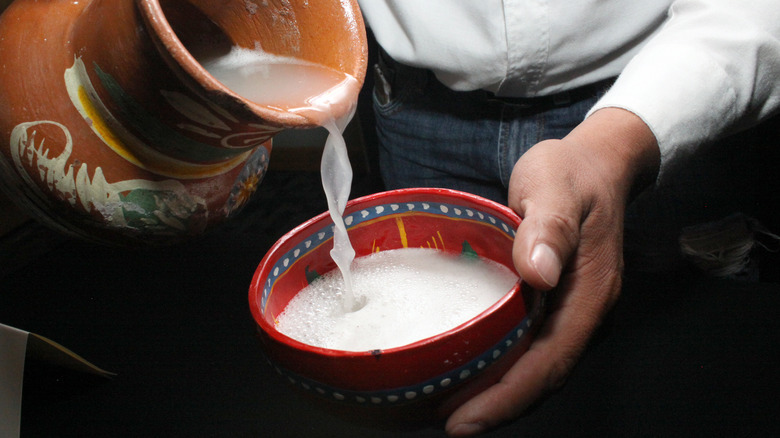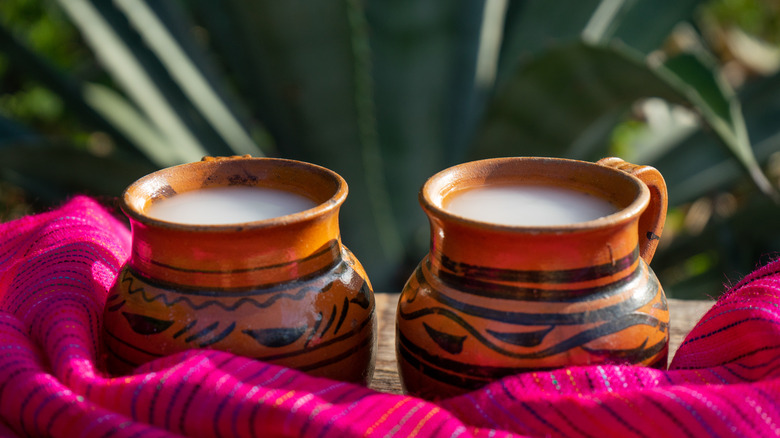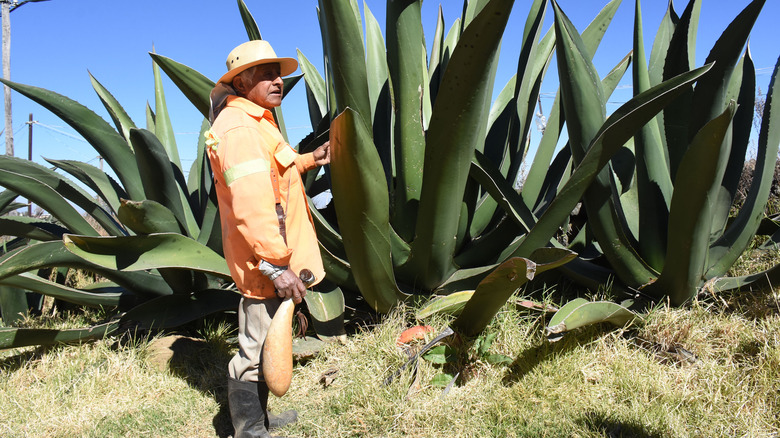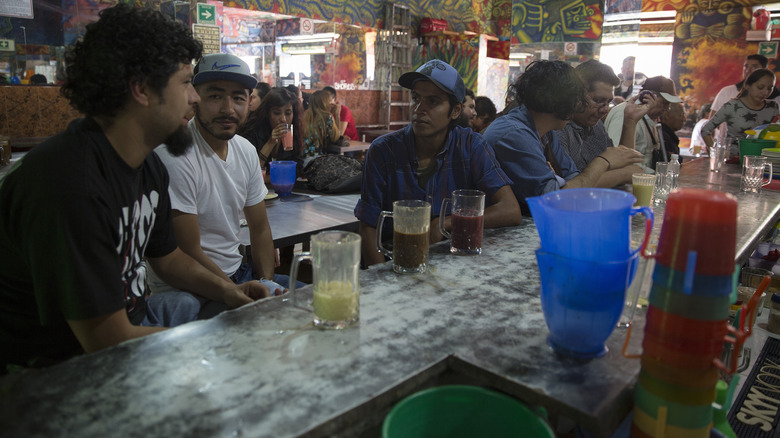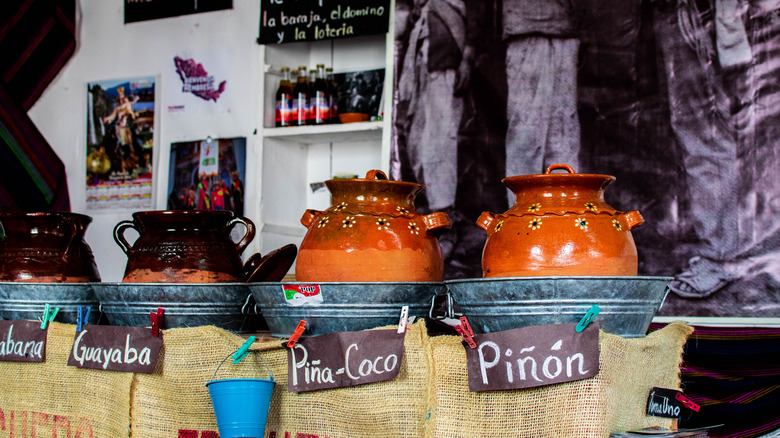What Is Pulque And What Does It Taste Like?
Have you ever heard of pulque? This lightly fermented Mexican beverage is made from the sap of the agave plant, famously known for its other (much more alcoholic) outputs, tequila and mezcal (via Serious Eats). But pulque is an altogether different beverage: with a short fermentation time of just 15 to 20 days (via El Universal), pulque is not distilled like those hard alcohols, resulting in a fizzy, sweet-and-sour beverage that Serious Eats notes is more similar to kombucha in taste. Pulque's most notable feature, perhaps, is its texture: it's a bit thick and almost — but not quite — slimy, as if it were "made from okra," according to Naomi Tomky of Serious Eats.
Pulque has a long history in its birthplace of Mexico, and while today it is enjoyed all over the country, its cultural capital is definitely Mexico City, home to a multitude of "pulquerías" — places in which to gather and drink fresh pulque — including several that date back to the early 1900s (via El Universal). Let's take a closer look at this fun, funky beverage.
Pulque: some history
Pulque is indigenous to Mexico, where, in the prehispanic era, indigenous communities considered the agave tonic a sacred drink of the gods (via Serious Eats). During the rule of the Aztecs — an empire which was established in the early 1300s and fell in 1521 (via World History) — Serious Eats explains the consumption of pulque was limited to the priestly class, only reaching the general population when the empire was felled by the Spanish. Pulque production then became a big business in the central Mexican highlands, though the newly arrived Spanish attempted to outlaw the sale and consumption of pulque as part of its general crackdown on native traditions (via Serious Eats). Ultimately, this attempt was unsuccessful, and the Crown even decided to tax the sale of pulque, raking in millions of pesos in the process.
As Mexico became more developed and the national railway system grew throughout the late 1800s, pulque was able to spread throughout the country and find new admirers, per Serious Eats. Pulque became the nation's main alcoholic drink, boosting maguey (agave) production. Recently, after a dip in popularity in the 1900s — due in part to severe competition from newly introduced beer — pulque is experiencing a resurgence and can be found not only in traditional establishments but in hip new pulquerías, too (via Culture Trip).
How is pulque made?
Pulque is made from the naturally expressed sap of the agave or maguey plant, which is referred to as aguamiel (honey water) (via Serious Eats). First, the heart of a mature agave plant is cut out, creating a space at the center of the plant. This cavity is scraped, encouraging the flow of the aguamiel towards the center, where it is collected in a bucket. The sap is then fermented, usually, in a plastic drum or tank; Thrillist notes open-topped wooden barrels were traditionally used in the past.
Leftover residues of the previous batch of pulque help ferment the newly added sap, as well as the wild yeast and bacteria in the air (via Thrillist). Per El Universal, a batch can technically become carbonated and ready to drink within a few hours, but is most often left to ferment for about two weeks before serving.
Pulque is best enjoyed freshly made, and it does not travel well (via Serious Eats). To enjoy it, you'll want to get as close to its source as possible, which typically means visiting a pulquería.
Where to find pulque
If you don't live in — or aren't visiting — Mexico, chances are you won't be able to find fresh pulque. We know of one pulquería in Chicago, and there are probably a handful more scattered across the states, but pulque is an endemically Mexican drink that doesn't often stray outside the country's borders. Your best bet for sampling a variety of pulques in a short period of time is to book a flight to Mexico City, where dozens of pulquerías, both trendy and traditional, still line the capital's streets.
Inside these festive bars, you'll find pulque sourced locally and brought in daily, as the stuff doesn't keep (via Serious Eats). At Las Duelistas, one of the country's oldest pulquerías, "natural" or unflavored pulque is served alongside about 45 other flavors, ranging from celery to pineapple to papaya (via El Universal). If you want to dive deep into the history and production of pulque — and then into a cold glass of it — you can even visit the Museo del Pulque (Pulque Museum), located in the city's historic center.
How to drink pulque
Once seated inside a pulquería, you can choose from any number of flavors of the stuff — and it's usually served in quantity. Part of pulque's appeal in prehispanic times is how filling it is — thick in texture and fairly high in calories, drinking pulque was a way to satiate the belly in lean times (via Serious Eats). That trend seems to have survived until today, because pulque is usually served in huge glasses or by the pitcher, in hues and flavors ranging from rose to orange to lime green.
Pulquerías almost always have a dive bar atmosphere, a loud, festive environment in which to suck down your thick, fizzy brew. It's certainly possible to get drunk off of pulque, and at least some of the people around you at the pulquería typically will. But because pulque has a relatively low alcohol content — just 4-6% — and is also extremely filling, it can be challenging to put away enough of the stuff to get tipsy (via VICE). But let's raise a glass to trying!
